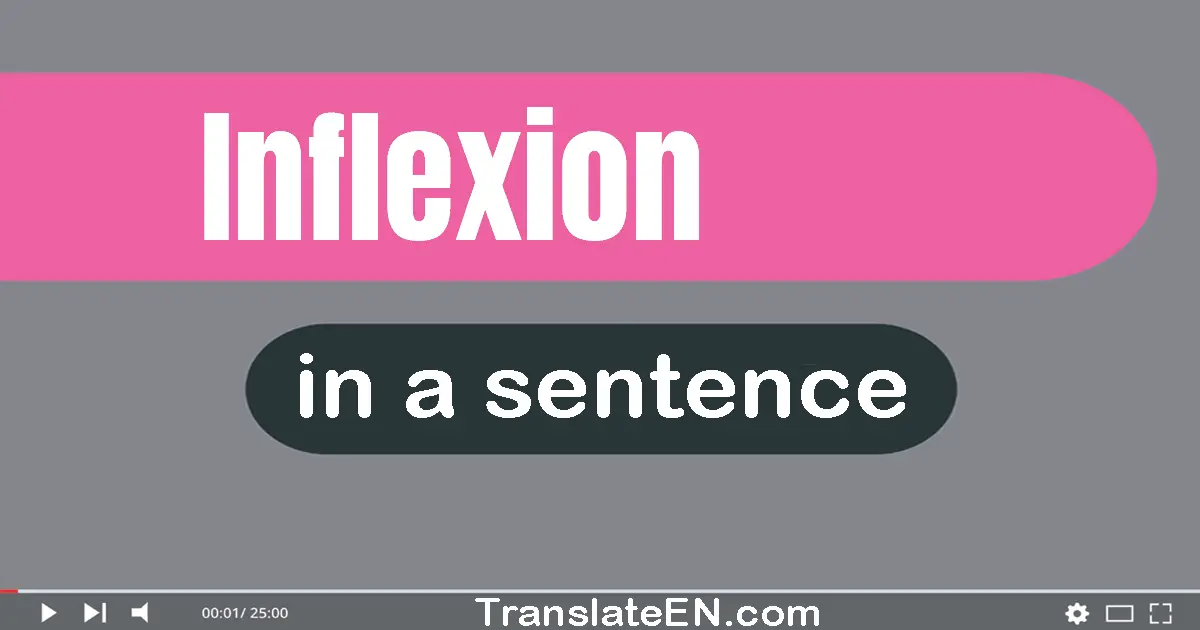Inflexion in a sentence
Synonym: change.
Meaning: A change in pitch or tone; often used in discussions of language and music.

(1) The inflexion of his eyebrows showed his confusion.
(2) The inflexion in his tone indicated his disapproval.
(3) The inflexion in her voice revealed her disappointment.
(4) The inflexion in her voice hinted at her hidden agenda.
(5) The inflexion in his voice hinted at his hidden agenda.
(6) The inflexion in his voice conveyed his genuine concern.
(7) The inflexion in her voice indicated that she was upset.
(8) He spoke with an inflexion that betrayed his nervousness.
(9) The inflexion in his voice hinted at his hidden emotions.
(10) The inflexion in his voice conveyed his genuine happiness.
Inflexion sentence
(11) The inflexion of the dancer's body was graceful and fluid.
(12) The inflexion in his voice made it clear that he was joking.
(13) She used an inflexion of surprise to express her astonishment.
(14) The inflexion of the guitar strings created a beautiful melody.
(15) The inflexion of the wind changed the direction of the sailboat.
(16) The inflexion of the writer's words conveyed a sense of urgency.
(17) She used an inflexion of sarcasm to mock his ridiculous statement.
(18) The inflexion in his voice indicated his disbelief in their story.
(19) The inflexion of the actor's voice added depth to his performance.
(20) The inflexion of the bird's chirp signaled the start of a new day.
Inflexion make sentence
(21) She used an inflexion of concern to express her worry for their safety.
(22) The inflexion of the athlete's muscles showed his strength and agility.
(23) She added an inflexion of excitement to her voice as she told the story.
(24) Her inflexion changed from sadness to anger as she recounted the events.
(25) Her inflexion shifted from happiness to sadness as she shared her story.
(26) The inflexion in her voice indicated her uncertainty about the decision.
(27) The inflexion in his voice revealed his disappointment in their actions.
(28) Her inflexion changed from fear to relief as she realized they were safe.
(29) The inflexion in her voice revealed her excitement for the upcoming event.
(30) The inflexion of the teacher's tone commanded attention from her students.
(31) His inflexion changed from anger to forgiveness as he realized his mistake.
(32) She added an inflexion of excitement to her voice as she announced the news.
(33) Her inflexion shifted from curiosity to understanding as she learned the truth.
(34) She added an inflexion of annoyance to her voice as she complained about the situation.
Inflexion meaning
Inflexion is a term that refers to the modulation or change in the tone, pitch, or stress of a word or phrase. It is a crucial aspect of language that helps to convey meaning and emotion in speech. In this article, we will provide some tips on how to use the word inflexion in a sentence.
1. Understand the meaning of inflexion Before using the word inflexion in a sentence, it is essential to understand its meaning. Inflexion refers to the change in the tone, pitch, or stress of a word or phrase. It is a crucial aspect of language that helps to convey meaning and emotion in speech.
2. Use inflexion to convey emotion One of the most common uses of inflexion is to convey emotion. By changing the tone or pitch of a word or phrase, you can convey a range of emotions, from excitement and enthusiasm to sadness and disappointment.
For example, you could say, "I'm so excited to see you!" with a rising inflexion to convey your enthusiasm.
3. Use inflexion to emphasize a point Another way to use inflexion is to emphasize a point. By stressing a particular word or phrase, you can draw attention to it and make it stand out.
For example, you could say, "I didn't say you were wrong, I said you were wrong!" with a strong inflexion on the second "wrong" to emphasize your point.
4. Use inflexion to indicate a question Inflexion is also used to indicate a question. By raising the pitch of your voice at the end of a sentence, you can indicate that you are asking a question.
For example, you could say, "Are you coming to the party?" with a rising inflexion at the end to indicate that you are asking a question.
5. Use inflexion to indicate sarcasm
Finally, inflexion can be used to indicate sarcasm. By using a particular tone or pitch, you can convey that you are being sarcastic or ironic.
For example, you could say, "Oh, great. Another meeting." with a flat inflexion to indicate that you are being sarcastic.
In conclusion, inflexion is a crucial aspect of language that helps to convey meaning and emotion in speech. By understanding its meaning and using it effectively, you can enhance your communication skills and convey your message more effectively.
The word usage examples above have been gathered from various sources to reflect current and historical usage of the word Inflexion. They do not represent the opinions of TranslateEN.com.
